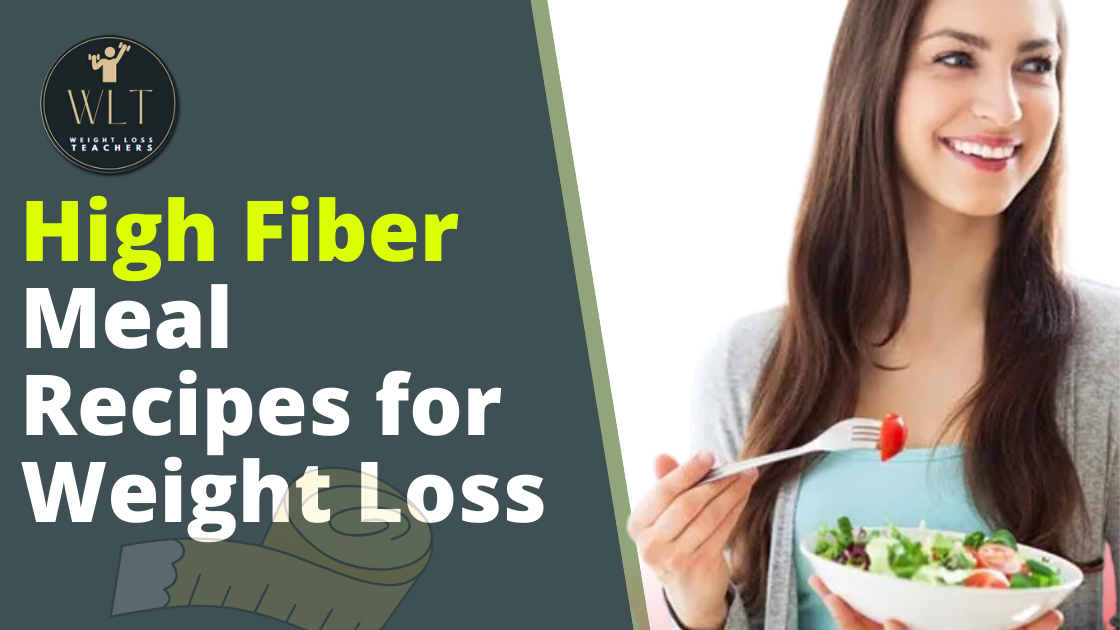
High Fiber Meal Recipes for Weight Loss
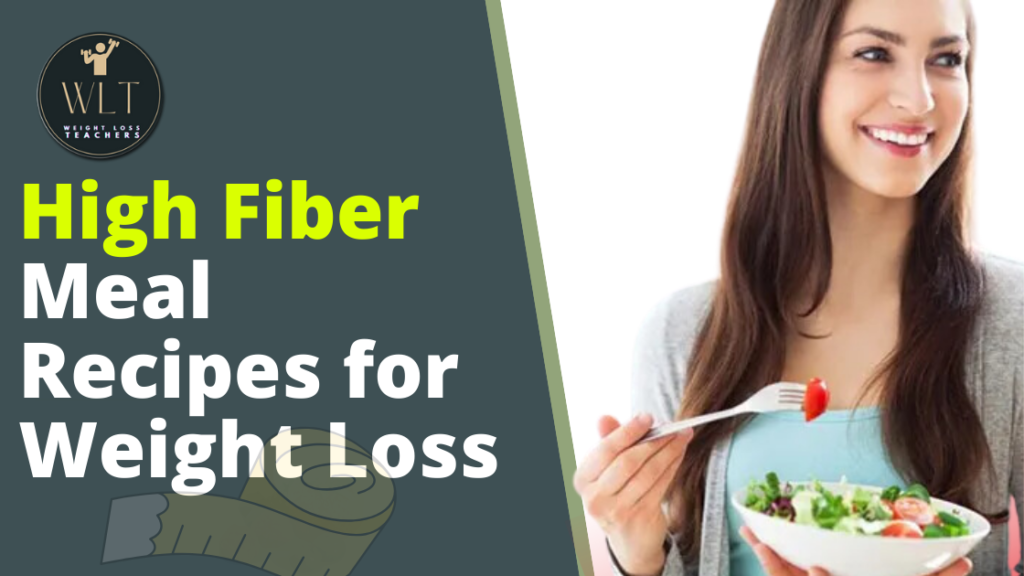
When considering the fundamental nutrients our bodies require for good health, fiber is often ignored. However, the importance of high fiber recipes for weight loss cannot be overemphasized. Fiber is a carbohydrate that the body’s digestive enzymes cannot break down and plays a significant role in many aspects of our health.
Table of Contents
Introduction
In this detailed article, we will look at the role of fiber in maintaining good health and encouraging weight loss. We’ll go over what fiber is, how it differs, and why it’s vital for weight loss. By the end of this talk, you will have a clear grasp of how fiber may be a game changer in your pursuit of a better, more balanced lifestyle.

What Exactly is Fiber?

Before we get into the myriad health benefits of fiber, let’s first define fiber. Fiber is a carbohydrate that is found in plant-based meals. The enzymes in the human body are unable to digest fiber, unlike other carbohydrates like sugars and starches. Instead, it passes mostly undamaged via the digestive system.
Fiber is classified into two types: soluble fiber and insoluble fiber. Each variety has its own set of characteristics and advantages.
Soluble Fiber: In the digestive tract, soluble fiber dissolves in water and forms a gel-like material. Oats, barley, beans, lentils, fruits (such as apples and oranges), and vegetables (such as carrots and sweet potatoes) all include this type of fiber. Soluble fiber’s gel-like structure inhibits digestion, which has several crucial implications for our health.
Insoluble Fiber: Insoluble fiber, unlike soluble fiber, does not dissolve in water. Instead, it travels through the digestive tract virtually unmodified. Insoluble fiber bulks up the stool, preventing constipation and encouraging regular bowel motions. Whole grains, nuts, seeds, and the peel of many fruits and vegetables contain this type of fiber.
Now that we’ve covered the fundamental types of fiber, let’s look at why fiber is important for overall health and how it can help with weight reduction.
Fiber’s Role in Weight Loss

- Enhancing Satiety
Fiber’s capacity to generate a feeling of fullness and satisfaction is one of the key reasons why it is important for weight loss. Fiber-rich foods take longer to chew and digest, and they have a higher volume-to-calorie content ratio. As a result, eating fiber-rich meals makes you feel more satisfied and less likely to overeat.
Consider having oatmeal for breakfast. Oats are a good source of soluble fiber. The soluble fiber in oatmeal forms a gel-like substance in your stomach, slowing the emptying of your stomach contents. This prolonged feeling of fullness may assist you in avoiding eating or overindulging later in the day.
- Caloric Intake Reduction
Fiber-rich meals, especially fruits and vegetables and whole grains, are frequently low in calories. This implies you can eat more of these items without dramatically raising your total calorie consumption. This is beneficial for people seeking to lose weight or maintain a healthy weight since it allows them to have pleasant meals without exceeding their daily calorie limits.
Consider a salad composed of leafy greens, tomatoes, cucumbers, and other veggies. This salad is high in fiber while being low in calories. You may eat a large portion of the salad without ingesting too many calories, making it a good choice for weight loss.
- Controlling Blood Sugar Levels
Fiber is essential for controlling blood sugar levels. Soluble fiber, in particular, helps decrease sugar absorption, reducing blood glucose rises and crashes. This more stable blood sugar profile may lessen cravings for sweet and high-calorie items, making it easier to follow a calorie-controlled diet.
Diabetes patients and those at risk of developing diabetes can greatly benefit from high fiber recipes for weight loss. Fiber helps manage the illness and reduces the risk of consequences linked to uncontrolled blood sugar by regulating blood sugar levels.
- Supporting Healthy Digestion
Fiber is necessary for a healthy digestive tract. Particularly insoluble fiber adds weight to the stool, softening it and encouraging regular bowel motions. This aids in the prevention of constipation and the proper elimination of waste from the body.
A healthy digestive tract is essential for general health and has a direct impact on weight management. When your digestive system is functioning properly, you are more likely to absorb nutrients efficiently and avoid the discomfort and bloating that come with digestive problems.
- Overeating and Emotional Eating Prevention
Fiber-rich foods are not only physically filling, but they can also help with psychological contentment. Many people indulge in emotional eating, which involves consuming food to cope with stress, worry, or other emotions. High fiber meals for weight loss can help minimize the need for emotional comfort by generating satiety and a sense of fullness.
Also, high fiber recipes for weight loss help promote conscious eating. You are less likely to rush through meals or consume empty-calorie snacks if you savor and appreciate the textures and flavors of fiber-rich foods.
- Gut Health Support
Fiber is a prebiotic, which means that it feeds the good bacteria in your stomach. These bacteria are essential for maintaining a healthy gut microbiome, which is linked to a variety of elements of overall health, including weight management.
According to new research, the composition of the gut microbiota can alter metabolism and body weight. Fiber-rich foods can promote a diverse and robust community of gut bacteria, which may aid in weight management and metabolic health.
Health Benefits of Fiber Go Beyond Weight Loss

While fiber plays an important role in weight management, its health benefits extend far beyond that. Let’s look at some of the other ways fiber contributes to general health:
Heart Health: Eating a high-fiber diet has been linked to a lower risk of heart disease. There is evidence that soluble fiber, in particular, lowers LDL (bad) cholesterol levels. Soluble fiber can help maintain healthy cholesterol levels by adhering to cholesterol particles in the digestive tract and encouraging their elimination, lowering the risk of atherosclerosis and heart attacks.
Diabetes Management: Fiber can be a beneficial ally for people who have diabetes or are at risk of getting it. Fiber, as previously stated, helps control blood sugar levels, minimizing fast spikes and crashes. This blood sugar stability is critical for diabetes treatment and, in some situations, can lessen the need for medication.
Colon Health: Insoluble fiber is essential for colon health. It increases stool bulk, which helps avoid constipation and lowers the risk of illnesses such as diverticulitis and hemorrhoids. A high-fiber diet may also reduce the incidence of colorectal cancer; however, additional research is needed to fully understand this link.
Weight Maintenance: Fiber is vital for weight maintenance in addition to weight loss. Many people who lose weight effectively struggle to keep it off in the long run. High fiber meals for weight loss can help by boosting satiety and reducing the chances of weight gain that often occur after a calorie deficit period.
Skin Health: Fiber-rich meals, such as fruits and vegetables, are high in vitamins, minerals, and antioxidants, all of which can help maintain healthy skin. Antioxidants protect skin cells from free radical damage, which can contribute to premature aging. A fiber-rich diet can help you have clear, vibrant skin.
Longevity: According to some research, high fiber meals for weight loss may be related to a longer life. This longevity effect could be related to fiber’s numerous health benefits, ranging from heart health to diabetes prevention.
Including Fiber in Your Diet
Now that we understand why fiber is important for maintaining excellent health and aiding weight loss, let’s talk about how to include more fiber in your diet:
Begin Slowly: If your current diet is poor in fiber, it is crucial to gradually incorporate it to minimize digestive pain. Sudden fiber consumption in bulk can cause bloating and gas. Begin by including one or two high fiber recipes for weight loss in your daily meals. Gradually increase your consumption over time.
Choose Whole Foods: To get the maximum fiber, choose whole, minimally processed foods. Whole grains, such as brown rice, quinoa, and whole wheat bread, as well as fresh fruits and vegetables, are high in fiber. These foods also contain a variety of other nutritional elements.
Experiment with Legumes: Legumes, such as beans, lentils, and chickpeas, are high in fiber and plant-based protein. They can be added to soups, salads, and other recipes to boost your fiber intake.
Snack Wisely: Instead of reaching for sugary or processed foods, opt for fiber-rich alternatives such as nuts, seeds, or whole fruit. These snacks can help you satisfy your hunger while also maintaining your energy levels throughout the day.
Read Labels: When shopping for packaged foods, read the nutrition labels to identify fiber-rich foods. Look for goods with healthy grains and few added sugars.
Stay Hydrated: It’s critical to drink plenty of water when you increase your fiber consumption. Fiber absorbs water and, when combined with proper hydration, can be more helpful in producing regular bowel motions.
Eat a Variety of Foods: Variety is essential for a balanced diet. Experiment with various fiber-rich foods to make your meals more interesting and pleasurable. To find new sources of fiber, experiment with new dishes and cuisines from around the world.
High Fiber Recipes For Weight Loss
Now that we’ve covered the fundamentals of fiber, let’s look at recipes for some delicious high fiber meals for weight loss.
- Salad with Quinoa and Black Beans
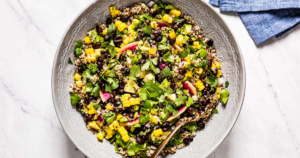
Quinoa is a high-fiber, protein-rich grain that is a fantastic choice for weight loss. This salad is high in fiber, protein, and good fats, making it a filling and nutritious lunch.
Ingredients:
- 1 cup washed and drained quinoa
- 1 can drained and rinsed black beans
- 1 chopped red bell pepper
- 1 diced yellow bell pepper
- 1 cup halved cherry tomatoes
- 1 diced avocado
14 cup chopped cilantro
- 2 tbsp of olive oil
- 2 teaspoons lime juice
- 1 tablespoon cumin
- Season with salt and pepper to taste
Instructions:
- Cook the quinoa according to package directions and set aside to cool.
- Toss together the quinoa, black beans, bell peppers, cherry tomatoes, avocado, and cilantro in a large mixing dish.
- In a small mixing bowl, combine the olive oil, lime juice, cumin, salt, and pepper.
- Toss the salad with the dressing to mix.
- Serve cold.
Note: There might be affiliate links mentioned here. We may receive a commission if you purchase a product through an affiliate link. There is no additional charge for you. Please do your own research before making any online purchases.
- Curry with Chickpeas and Spinach
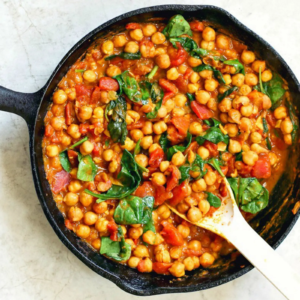
Chickpeas are a high-fiber source of plant-based protein that is ideal for weight loss. This curry is flavorful and high in fiber, making it a filling and healthy dinner.
Ingredients:
- 1 tbsp. coconut oil
- 1 sliced onion
- 2 minced garlic cloves
- 1 tbsp. grated ginger
- 2 tablespoons cumin powder
- 2 tablespoons coriander powder
- 12 tsp turmeric
- 1 can drained and rinsed chickpeas
- 1 tbsp chopped tomatoes
- 1 cup vegetable stock
- 2 cups spinach
- Season with salt and pepper to taste
Instructions:
- Melt the coconut oil in a large saucepan over medium heat.
- Cook for 5 minutes, or until the onion is tender and translucent, with the onion, garlic, and ginger.
- Cook for another minute after adding the cumin, coriander, and turmeric.
- Bring the chickpeas, diced tomatoes, and vegetable broth to a simmer.
- Simmer for 10-15 minutes, or until the sauce has slightly thickened.
- Stir in the spinach until it is wilted.
- Season to taste with salt and pepper.
- Serve immediately with brown rice.
- Lentil Soup
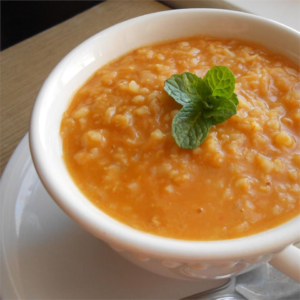
Lentils are high in fiber and protein, making them a good addition in high fiber recipes for weight loss. This lentil soup is filling, tasty, and high in fiber and nutrients.
Ingredients:
- 1 teaspoon olive oil
- 1 sliced onion
- 2 minced garlic cloves
- 1 tablespoon cumin
- 1 tsp. coriander
- 1 tsp smoked paprika
- 1 cup rinsed and drained red lentils
- 4 cups veggie broth
- 1 tbsp chopped tomatoes
- 2 cups kale, chopped
- Season with salt and pepper to taste
Instructions:
- Heat the olive oil in a big pot over medium heat.
- Cook for 5 minutes, or until the onion is tender and transparent, with the onion and garlic.
- Cook for another minute after adding the cumin, coriander, and smoked paprika.
- Bring the lentils, vegetable broth, and diced tomatoes to a boil.
- Reduce to a low heat and cook for 20-25 minutes, or until the lentils are cooked.
- Stir in the kale until it is wilted.
- Season to taste with salt and pepper.
- Serve immediately.
- Chickpea and Sweet Potato Stew
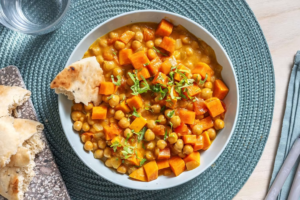
Sweet potatoes are high in fiber and vitamins, making them a healthy addition to high fiber meals for weight loss. This stew is high in fiber, protein, and healthy fats, making it a filling and tasty dinner.
Ingredients:
- 1 teaspoon olive oil
- 1 sliced onion
- 2 minced garlic cloves
- 1 teaspoon cumin powder
- 1 teaspoon coriander powder
- 12 tsp smoked paprika
- 2 peeled and chopped sweet potatoes
- 1 can drained and rinsed chickpeas
- 4 cups veggie broth
- Season with salt and pepper to taste
Instructions:
- Heat the olive oil in a big pot over medium heat.
- Cook for 5 minutes, or until the onion is tender and transparent, with the onion and garlic.
- Cook for another minute after adding the cumin, coriander, and smoked paprika.
- Bring the sweet potatoes, chickpeas, and vegetable broth to a boil.
- Reduce to a low heat and continue to cook for 20-25 minutes, or until the sweet potatoes are cooked.
- Season to taste with salt and pepper.
- Serve immediately.
- Broccoli with Garlic Whole Wheat Pasta
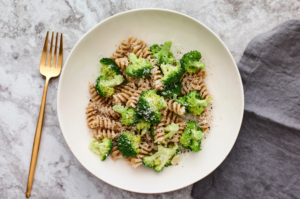
Whole wheat pasta is higher in fiber and complex carbs than typical white pasta, making it a healthier option for people looking for high fiber recipes for weight loss. This pasta recipe is high in fiber and nutrients, making it a filling and healthy dinner.
Ingredients:
- 8 oz. whole wheat pasta
- 2 cups florets broccoli
- 2 minced garlic cloves
- 2 tbsp of olive oil
- Season with salt and pepper to taste
- Parmesan cheese (optional) for serving
Instructions:
- Cook and drain the pasta according to package directions.
- Heat the olive oil in a large skillet over medium heat.
- Cook for 5-7 minutes, or until the broccoli is soft.
- Cook for another minute after adding the garlic.
- Toss the cooked pasta into the skillet to mix.
- Season to taste with salt and pepper.
- If wanted, serve hot with grated Parmesan cheese.
- Yogurt and Berry Parfait

Berries are high in fiber and antioxidants, making them a nutritious addition to any meal. This parfait is high in fiber, protein, and healthy fats, making it an ideal dessert or breakfast alternative.
Ingredients:
- 1 cup Greek yogurt, plain
- 1 cup berry mixture (strawberries, blueberries, raspberries)
- 1 granola cup
- 1 teaspoon honey
Instructions:
- Combine the Greek yogurt and honey in a small mixing dish.
- Layer the yogurt mixture, mixed berries, and granola in a glass or parfait dish.
- Continue until all of the ingredients are used up, finishing with a layer of mixed berries.
- Serve right away.
FAQs
What exactly is fiber, and why is it so crucial to our health?
Fiber is a form of carbohydrate present in plant-based foods that the body’s enzymes cannot break down. It is essential for our health because it is involved in many facets of our well-being, including digestion, weight control, heart health, and others.
What are the two most common forms of fiber and how do they differ?
Fiber is classified into two types: soluble fiber and insoluble fiber. In the digestive system, soluble fiber dissolves in water and forms a gel-like substance, whereas insoluble fiber does not dissolve in water and adds bulk to the stool.
Soluble fiber promotes fullness and aids in weight loss in what ways?
In the stomach, soluble fiber produces a gel-like material that delays the emptying of the stomach contents. This prolonged feeling of fullness can help reduce overeating and snacking, making calorie management and weight control easier.
Can you give me an example of a high-fiber food that helps you lose weight?
A salad composed of leafy greens, tomatoes, cucumbers, and other veggies is a fantastic example. It’s high in fiber and low in calories, so you may eat a large piece without exceeding your daily calorie restriction, which is beneficial for weight management.
Why is fiber vital for weight management and how does it help regulate blood sugar levels?
Soluble fiber decreases blood glucose spikes and crashes by decreasing the absorption of sugar. Blood sugar levels that are stable reduce cravings for sugary and high-calorie foods, making it easier to follow a calorie-controlled diet and support weight management.
What role does fiber play in digestive health?
Insoluble fiber softens and softens the stool, enabling regular bowel motions. This helps to prevent constipation and guarantees proper waste evacuation, both of which are important for overall health and weight management.
What role does a high-fiber diet have in preventing overeating and emotional eating?
Fiber-rich foods satisfy both physically and psychologically, producing a sense of fullness. This can lower the desire to overeat and turn to food for emotional comfort, resulting in better calorie control.
Can you describe how fiber promotes intestinal health and how it may help with weight loss?
Fiber functions as a prebiotic, feeding beneficial intestinal bacteria. By regulating metabolism and body weight, a diversified and robust gut microbiota impacted by fiber-rich meals may benefit weight control and metabolic health.
What are some of the additional health benefits of a high-fiber diet, aside from weight loss?
A high-fiber diet has been linked to a variety of health benefits, including better heart health, diabetes control, colon health, weight maintenance, improved skin health, and possibly even extended longevity.
What are some simple ways to incorporate extra fiber into one’s diet?
To avoid stomach pain, gradually add fiber into your diet, choose whole foods, experiment with legumes, choose smart fiber-rich snacks, read nutrition labels, remain hydrated, and diversify your diet to include varied fiber sources such as fruits, vegetables, whole grains, and nuts.
Conclusion
Fiber is an important ingredient that might help you lose weight by keeping you full and satisfied. The high fiber meals for weight loss are not only healthy but also tasty and easy to prepare. Incorporating these foods into your diet can aid in weight loss while also encouraging overall health and wellness. Always choose whole, minimally processed foods, and pay attention to your body’s hunger and fullness cues. Happy making and eating high fiber foods!
Disclaimer: The information provided in this article is for educational purposes only and should not be considered as a substitute for medical advice. Consult a healthcare professional before implementing any home remedies or making significant changes to your lifestyle.






